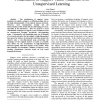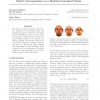608 search results - page 21 / 122 » Support Vector Machines for 3D Shape Processing |
CICLING
2006
Springer
15 years 1 months ago
2006
Springer
The disambiguation of verbs is usually considered to be more difficult with respect to other part-of-speech categories. This is due both to the high polysemy of verbs compared with...
106
click to vote
CIBCB
2006
IEEE
15 years 3 months ago
2006
IEEE
– The visualization of support vector machines in realistic settings is a difficult problem due to the high dimensionality of the typical datasets involved. However, such visuali...
ICML
2005
IEEE
15 years 10 months ago
2005
IEEE
We propose machine learning methods for the estimation of deformation fields that transform two given objects into each other, thereby establishing a dense point to point correspo...
JMLR
2008
14 years 9 months ago
2008
Linear support vector machines (SVM) are useful for classifying large-scale sparse data. Problems with sparse features are common in applications such as document classification a...
ML
2002
ACM
14 years 9 months ago
2002
ACM
I describe a framework for interpreting Support Vector Machines (SVMs) as maximum a posteriori (MAP) solutions to inference problems with Gaussian Process priors. This probabilisti...


